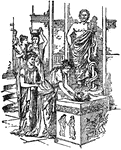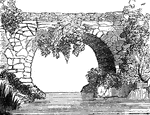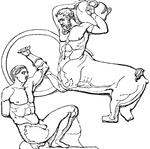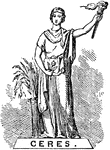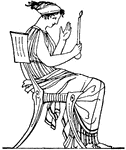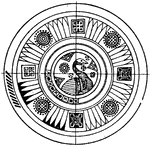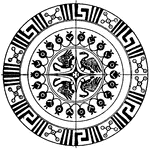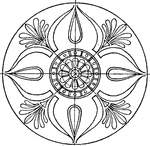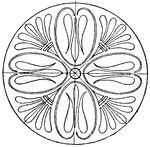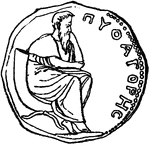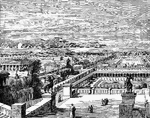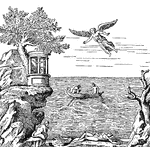
Bust of Aspasia
"Pericles, after divorcing a wife with whom he had lived unhappily, took his mistress Aspasia to his…

Mourning Athena
"A tablet of Pentelic marble. Athena, leaning on her spear, is gazing with downcast head at a grave…
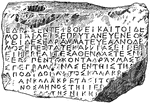
An Athenian Inscription
"A decree of the Council and Assembly dating from about 450 B.C."—Webster, 1913

Ancient Athens
"The mosted noted of the orations of Isocrates is the Panathenaicus or Panegyric of Athens, a work on…
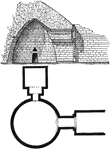
Treasury of Atreus
The Treasury of Atreus or Tomb of Agamemnon is an impressive "tholos" tomb at Mycenae, Greece (on the…

Treasury of Atreus Doorway
The Treasury of Atreus or Tomb of Agamemnon is an impressive "tholos" tomb at Mycenae, Greece (on the…

Auletris
"Auletris.- Performer on the double flute or diaulos. (From a Greek red-figured vase; 5th century B.C.)"-Whitney,…
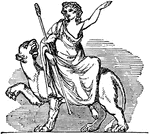
Bacchus
"The god of wine, was the son of Zeus and Semele, the daughter of Cadmus. Before his birth, Semele fell…

Greek Bedstead
The Greek bedstead had a vase painting and served partly as bed, and partly as couch.

Procession of Bel
"The god Bel is generally known by his Greek name Belus. But the attributes given him by the Greek authors…
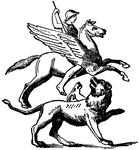
Bellerophon, Pegasus, and the Chimera
"After the conquest of the Chimaera, Bellerophon was exposed to further trials and labors by his unfriendly…
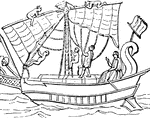
Greek Boat
"The masts were usually taken down when the vessel arrived in port, and raised again when it was about…

Boreas and Orithyia
"Boreas loved the nymph Orithyia, and tried to play the lover's part, but met with poor success." —Bulfinch,…

Boxing
"The Olympic games were of greater efficacy than the Amphictyonic Council in promoting the spirit of…

Curved buccina
"The buccina is curved for the convenience of the performer, with a very wide mouth, to diffuse…
Straight buccina
"A copy of an ancient sculpture taken from Blanchini's work, it still retains the original form of the…
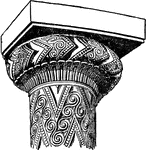
Early Greek Capital
An illustration of an early Greek capital. In several traditions of architecture including Classical…

Grecian Doric Capital
"The Doric Order is, in architecture, the second of the five orders, being that between the Tuscan and…
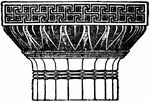
Grecian Doric Capital
"The Doric Order is, in architecture, the second of the five orders, being that between the Tuscan and…

Grecian Doric Capital
"The Doric Order is, in architecture, the second of the five orders, being that between the Tuscan and…
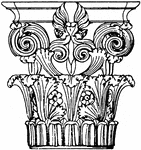
Greek Corinthian Capital
The Greek Corinthian capital is found in a monument in Lysikrates, Athens. It is a design of spiral…
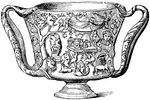
Carchesium
"The carchesium was a beaker, or drinking-cup, which was used by the Greeks in very early times. It…
Greek Caryatid
The Greek Caryatid is a female figure used as a support in place of a column. It is found in the temple…

Centaur
"These monsters were represented as men from the head to the loins, while the remainder of the body…

Greek Chariot
"In the battles, as depicted by Homer, the chiefs are the only important combatants, while the people…

Chiron
"Chiron was instructed by Apollo and Diana, and was renowned for his skill in hunting, medicine, music,…
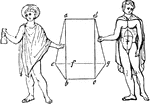
Chlamys
"The chlamys was a species of cloak or scarf, oblong instead of square, its length being generally about…

Cithara
A seven-stringed lyre with a deep, wooden sounding box. Primarily used by the ancient Greeks, this instrument…

Clisthenes in the Olympic Games
Clisthenes, also known as the Father of Athenian democracy, is depicted competing in a chariot race…
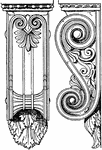
Greek Console
The Greek console is shown in the front and side view. It is found as a support to the North door of…
!["Afterwards [Solon] went to Sardis and made the acquaintance of Cresus. It was on this occasion that the celebrated interview occurred which has been so much repeated for its lesson. Cresus, desiring to make an impression on his visitor, took him into his treasury and showed him his riches."—Ridpath, 1885](https://etc.usf.edu/clipart/78900/78916/78916_treasures_mth.gif)
Cresus Showing Solon His Treasures
"Afterwards [Solon] went to Sardis and made the acquaintance of Cresus. It was on this occasion that…
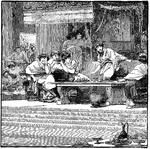
Banquet of Damocles
Image depicting a mythical moral anecdote, consisting of two morals. The first that regardless of who…
